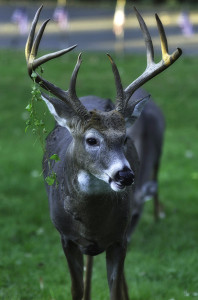 With spring upon us, it is time to start getting those whitetail deer food plots in the ground. No, I am not advocating disobeying Illinois’ baiting laws, so let’s begin by reviewing those laws. The following is taken directly out of the Illinois Department of Natural Resources Hunting and Trapping Digest.
With spring upon us, it is time to start getting those whitetail deer food plots in the ground. No, I am not advocating disobeying Illinois’ baiting laws, so let’s begin by reviewing those laws. The following is taken directly out of the Illinois Department of Natural Resources Hunting and Trapping Digest.
“It is unlawful to make available food, salt, mineral blocks or other products for ingestion by wild deer or other wildlife in areas where wild deer are present at any time.”
“It is illegal to feed deer at any time and/or take deer by the use or aid of bait or baiting of any kind. Despite their widespread availability, deer baits and attractants commonly sold in stores are also illegal to use at any time except for use by properly licensed owners of captive cervids while feeding captive animals. For the purpose of this section, “bait” means any material, whether liquid or solid, including food, salt, minerals and other products that can be ingested, placed or scattered in such a manner as to attract or lure white-tailed deer. “Baiting” means the placement or scattering of bait to attract deer. An area is considered as baited during the presence of and for 10 consecutive days following the removal of bait. For the purposes of taking white-tailed deer, nothing in this section shall be construed to prevent the manipulation, including mowing or cutting, of standing crops as a normal agricultural or soil stabilization practice, food plots or normal agricultural practices, including planting, harvesting and maintenance, such as cultivating, or the use of products designed for scent only and not capable of ingestion, solid or liquid, placed or scattered, in such a manner as to attract or lure deer.”
So, what are the exceptions to the law? Again taken directly from the IDNR Hunting and Trapping Digest.
1. Feeders for wildlife other than deer so long as deer are excluded from the feed in and around the feeder by fencing or other barriers.
2. Standing crops planted and left standing as food plots for wildlife.
3. Grain or other feed scattered or distributed soley as a result of normal agricultural, gardening or soil stabilization practices.
4. Standing, flooded or manipulated natural vegetation or food/seed deposited by natural vegetation.
Whitetail Deer Food Plots
Food plots are a way the sportsman or nature enthusiast can provide nutrients for deer, but as you read above, Illinois law prohibits any other means of feeding whitetail deer. The law was written and put in place after the discovery of Chronic Wasting Disease (CWD). Because of the potential for this disease to spread, all attractants except food plots were banned.
There are many types of deer forage available on the market (to many to list here).
Alfalfa – According to a study conducted by the University of Illinois Extension: College of Agricultural, Consumer and Environmental Sciences, alfalfa can be seeded in the spring or fall at a rate of 12-15 pounds per acre. However, alfalfa is a high maintenance plant and must be sprayed with insecticides to avoid being destroyed. The study indicated that if deer have a choice of alfalfa, soybeans, or corn, 90% percent of the time, they will choose alfalfa.
Ladino clover – The study indicated that this seed may be planted in spring or fall at a rate of 2 – 4 pounds per acre. This forage usually does not require special attention.
Red clover – The study indicated that this seed can also be planted in spring or fall at a rate of 8 – 10 pounds per acre and is relatively easy to establish. Red clover, however, doesn’t usually last as long as Ladino clover.
Soybeans – Usually planted between April 15th and September 15th at a rate of 45 – 60 pounds per acre. Soybeans are an excellent attractant for deer, but must also be sprayed to keep weeds down.
Winter oats – Usually planted before September 15th at a rate of 100 pounds per acre.
Wheat – Another excellent attractant usually planted in the fall after September 15th. Wheat can be planted at a rate of 90 – 120 pounds per acre, but should be fertilized in the winter.
How big should your food plot be?
Start small. Food plot seed can be costly to be done correctly. One-fourth to one-half acre plots are much easier to get started and manage. You can always grow from there. Place your food plot near a woodland opening, along a woodland tree line or near a water source. Deer love acorns from an oak tree, so planting near large acorn producers will be a travel path for deer. With your food plot in place, you may start seeing larger bucks during the rut that you wouldn’t usually see at any other time of year.
Although there are many other choices available, those options listed here will provide a nice food plot for deer and the reward is knowing you are helping support the survival of wildlife and improve your hunt or observation of the elusive whitetailed deer.
#Wired4Backstraps
#Wired4Hunting

